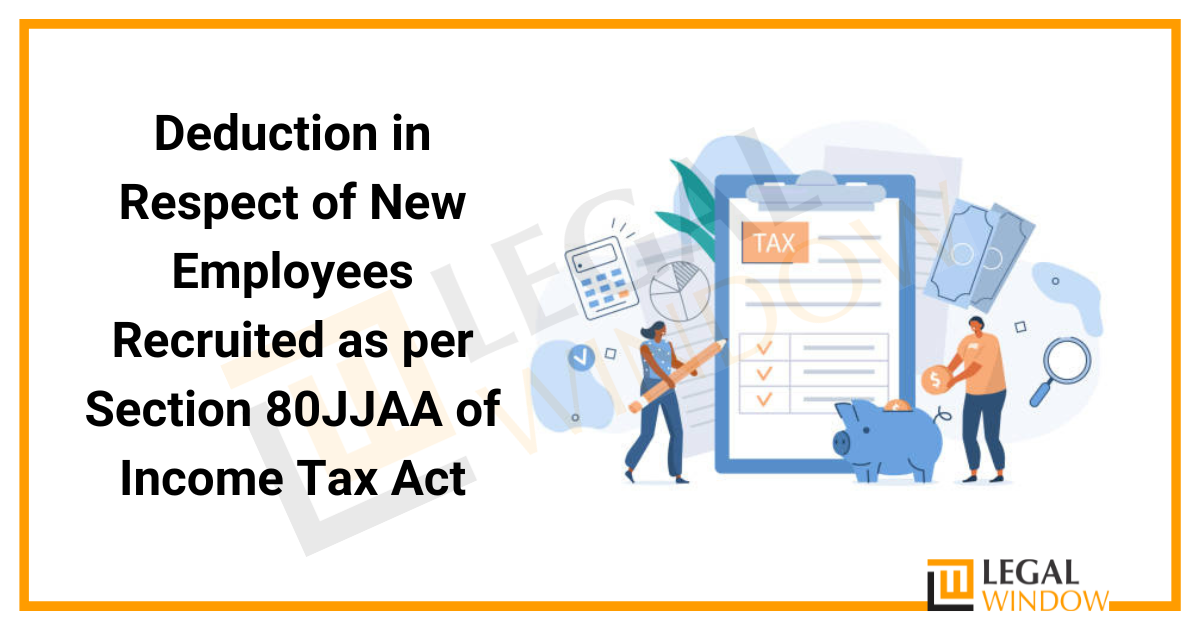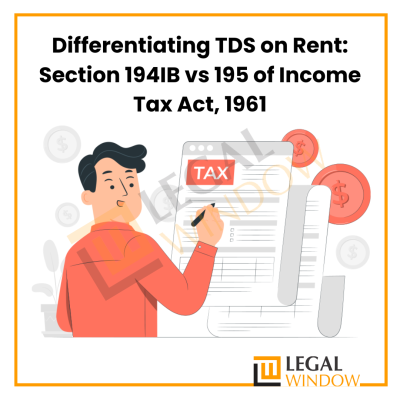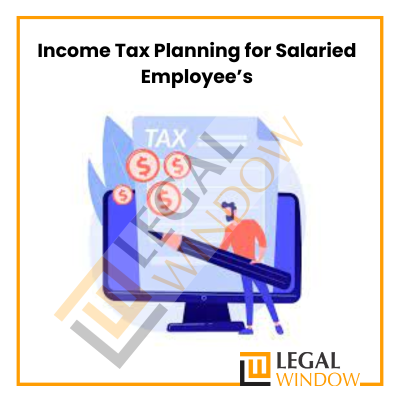Deduction in Respect of New Employees Recruited as per Section 80JJAA of Income Tax Act
- December 3, 2022
- Income Tax
 Unemployment is a significant issue in every country. Section 80JJAA was enacted to increase employment and encourage individuals. Section 80JJAA allows you to claim a deduction for hiring new or additional staff. The clause has been included in the Income Tax Act, 1961 (Act) to encourage companies to hire new staff on a regular basis. This Income Tax Act deduction is available to all taxpayers for the purpose of providing job opportunities. The Section 80JJAA deduction is intended to create jobs in all areas of the Indian economy.
Unemployment is a significant issue in every country. Section 80JJAA was enacted to increase employment and encourage individuals. Section 80JJAA allows you to claim a deduction for hiring new or additional staff. The clause has been included in the Income Tax Act, 1961 (Act) to encourage companies to hire new staff on a regular basis. This Income Tax Act deduction is available to all taxpayers for the purpose of providing job opportunities. The Section 80JJAA deduction is intended to create jobs in all areas of the Indian economy.
Short Glimpse
Section 80JJAA of the Income Tax Act, 1961 is a tax incentive for job creation and offers a deduction from an assessee’s income from the business for the hire of additional employees by the assessee. This deduction is granted to encourage job creation in the country. If claimed, this deduction can give a deduction of up to 190% of the expenditures expended for salary and wages paid to new workers.
Section 80JJAA as per Income Tax Act, 1961
In which the total income of the taxpayer to whom section 44AB applies includes any profits and gains made through business, under the compliance mentioned in sub-section (2), a deduction equal to 30% of additional employee costs incurred for the business in the previous year is allowed for three assessment years, including the assessment year in which this employment is provided.
All assessees can claim the Section 80JJAA deduction under the Income Tax Act, 1961 for job creation. Section 80JJAA deduction is intended to generate employment in all industries and has been extended to the fiscal year 2017-18.
Qualification for claiming Deduction under Section 80JJAA
Taxpayers whose entire income includes company earnings or gains may claim the Section 80JJAA deduction. To be qualified for the deduction under Section 80JJAA, the taxpayer must meet all of the following requirements:
- The company should not have been founded by dividing up or reconstructing an existing company. A business, on the other hand, might have been founded as a consequence of re-establishment, reconstruction, or resurrection.
- The taxpayer should not have acquired the business through a transfer from another person or through business reorganization.
- The taxpayer must file an Income Tax Return and a Chartered Accountant report on Form 10DA before the due date.
Legal Window will offer you all of the essential services and legal advice for submitting your Income Tax Return, as well as guidance for other compliances. To file your Income Tax Return, please contact our staff at 072407-51000 or admin@legalwindow.in.
Meaning of an Additional Employee
Additional employee implies an employee who was employed during the previous year and whose employment increased the overall number of employees employed by the employer as of the final day of the prior year but excludes:
- An employee whose total monthly earnings exceed Rs.25, 000.
- An employee for whom the government pays the complete payment under the Employees Pension Scheme.
- An employee who has worked for less than 240 days in the past two years. The minimum employment duration for garment makers is 150 days.
- Employees who do not contribute to a recognized provident fund.
Concept of Emoluments
Emoluments are any sums paid or payable to an employee in place of his service, regardless of the name, but do not include:
- Any payment paid or payable by the employer to any pension fund, provident fund, or another fund for the benefit of the employee under any current legislation.
- Gratuity, severance pay, leave encashment, voluntary retrenchment benefits, pension commutation, and other lump-sum payments made or payable to an employee at the time of termination of employment, superannuation, or voluntary retirement.
What Does Additional Employee Cost Mean?
Total emoluments paid or payable to extra employees engaged during the preceding year are referred to as additional employee costs. The Act states that the additional staff cost in the case of an existing company is nil if:
- The overall number of employees employed on the last day of the previous year has not increased.
- Emoluments are paid in any other way than via account payee cheque, account payee bank draught, or ECS through a bank account. Furthermore, in the first year of operation, emoluments paid or payable to workers employed during that year are considered to constitute the increased personnel cost.
Submission of Form 10DA
Taxpayers claiming an income tax deduction under Section 80JJAA must complete Form 10DA, which includes a report from a Chartered Accountant. Form 10DA is required to be filed when claiming a deduction under Section 80-JJAA. The following are some key features of Form 10DA:
- The due date for submitting Form 10DA is the same for assessees for return filing under Section 139(1), as it has to be given simultaneously with the return of income.
- Form 10DA is filed electronically at the Income Tax Department Portal.
- DSC is required for Form 10DA submission, but not with the assistance of EVC.
The conditions to claim Deduction under Section 80JJAA of the Income Tax Act, 1961
The following requirements must be met in order to claim the deduction under this section:
- The assessee must have income from the Business Head and must have his accounts audited in accordance with Section 44AB, coupled with a CA report in Form 10DA.
- It should be a new company. It should not be founded by dividing or rebuilding an existing business.
- Business is not acquired through a transfer from another person or through a business reorganization.
- The deduction must be claimed on the Income Tax Return.
Deduction amount under Section 80JJAA of the Income Tax Act, 1961
Section 80JJAA allows for a deduction of 30% of Additional Employee Costs incurred in the conduct of such business in the previous year for 3 Assessment Years, including the assessment year relevant to the previous year, subject to the fulfillment of the requirements mentioned in the section.
Regardless of any changes in job status or pay levels, the amount of deduction will stay consistent for all three years. For example, the amount of deduction claimed in the first year would stay constant in the following two years, even if certain employees, including those for whom the additional deduction is claimed, left the firm or their pay exceeded Rs. 25,000 per month.
 Takeaway
Takeaway
Section 80JJAA does not define any requirements for the continuous employment of extra personnel in the next two fiscal years. As a result, even if the employee resigns from the company in the second or third year, the amount of deduction calculated in the first year remains untouched. The government has paid ESI and EPF through this system. As a result, those employees will be excluded if the government has paid any of the employee’s remuneration for services rendered. Hence we can say that it is one of the most fruitful initiatives by the government for the betterment of New Employees.
CA Pulkit Goyal, is a fellow member of the Institute of Chartered Accountants of India (ICAI) having 10 years of experience in the profession of Chartered Accountancy and thorough understanding of the corporate as well as non-corporate entities taxation system. His core area of practice is foreign company taxation which has given him an edge in analytical thinking & executing assignments with a unique perspective. He has worked as a consultant with professionally managed corporates. He has experience of writing in different areas and keep at pace with the latest changes and analyze the different implications of various provisions of the act.
Categories
- Agreement Drafting (23)
- Annual Compliance (11)
- Change in Business (36)
- Company Law (148)
- Compliance (90)
- Digital Banking (3)
- Drug License (3)
- FEMA (17)
- Finance Company (42)
- Foreign Taxation (6)
- FSSAI License/Registration (14)
- GST (120)
- Hallmark Registration (1)
- Income Tax (202)
- Latest News (34)
- Miscellaneous (165)
- NBFC Registration (8)
- NGO (14)
- SEBI Registration (6)
- Section 8 Company (7)
- Start and manage a business (21)
- Startup/ Registration (130)
- Trademark Registration/IPR (40)
Recent Posts
About us
LegalWindow.in is a professional technology driven platform of multidisciplined experts like CA/CS/Lawyers spanning with an aim to provide concrete solution to individuals, start-ups and other business organisation by maximising their growth at an affordable cost.








